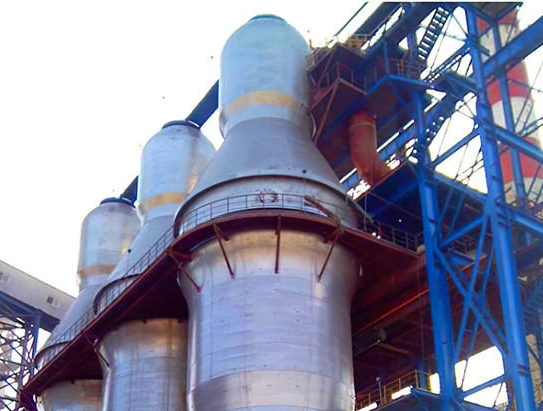- 06
- Nov
Masonry process of internal combustion ceramic burner in hot blast stove
Masonry process of internal combustion ceramic burner in hot blast stove
熱風ストーブの内燃セラミックバーナーの全体的な建設プロセスは、耐火レンガメーカーによって組織されています。

The internal combustion type ceramic burner has a complex structure, and there are many specifications of refractory bricks. The bricks are required to have a complete shape and accurate dimensions during masonry. The special-shaped bricks need to be “checked and seated”. Check and adjust the elevation, flatness, and radius of the masonry at any time. Make it meet the design and construction requirements.
1.内燃セラミックバーナーの構築プロセス:
(1) Before the burner is built, the deflector shall be prefabricated according to the design requirements, and then the bottom castable shall be constructed at the lower part of the burner.
(2)キャスタブルの最下層が注がれた後、支払いを開始します。 まず、燃焼室のクロスセンターラインとガスダクト下部のエレベーションラインを引き出し、燃焼室の壁に印を付けます。
(3)組積造の下部に耐火レンガの最下層を下から上に層ごとに置き、組積造プロセス中の任意の時点で組積造の高さとその表面の平坦度を確認および調整します(平坦度の許容誤差は小さくなります) 1mmより)。
(4) As the masonry height rises, the cross center line and the elevation line should be simultaneously extended upwards, so that the masonry quality can be controlled and checked at any time during the masonry process.
(5)最下層の耐火れんがの施工が完了したら、ガス通路壁の施工を開始します。 建設シーケンスも下から上に実行されます。 工事が一定の高さに達した後、工事壁を流し込んだ後、流し込み材料層を流し込み、デフレクターを設置します。
(6)デフレクターの取り付け:
1)バッフルの最初の層が配置されたら、支持レンガを使用して固定し、木製のくさびを使用して締め、ボードの継ぎ目の間に上部注入を使用し、注入材料を使用して密に充填します。
2)第XNUMX層デフレクターの設置が完了したら、前のプロセスを繰り返し、ガス通路壁の構築を続け、キャスタブルを注ぎ、次に第XNUMX層デフレクターを設置します。
3) When installing the second layer of deflector, it should be in place accurately, the pin hole should be filled with 1/3 of the high temperature adhesive, and the gap between the plates should also be densely filled with pouring material.
4) When installing the backflow plate, check and confirm that the installation position and dimensions are correct before fixing it.
5) Repeat the above process to n-layer deflector to complete the masonry of the part below the gas passage chute.
(7)空気通路の組積造:
1)また、下から構築し、下のレンガ(平坦度1mm未満)を配置してから、空気通路の壁に耐火レンガを構築します。
2)空気通路壁の耐火レンガがガス通路シュートの支持レンガ下部の立面線に達したら、壁の注入を開始し、材料を注入します。 ガス通路シュート壁の支持レンガの上に1〜2層のレンガを敷設した後、レンガを再度敷設します。 空気通路の壁に耐火レンガを作ります。
3)組積造がバーナー位置に達したら、下部に乾層を設置し、必要に応じて伸縮継手を確保し、ライナーに3mmの耐火繊維フェルトと滑り層としての油紙を充填する必要があります。 伸縮継手の継続的なスライドを確保するために、オイルペーパーの下に耐火性の泥を使用しないでください。
4)伸縮継手は、バーナーと周囲のキャスタブルの間のギャップ用に予約する必要があり、セラミックバーナーと燃焼室壁の間のギャップは、設計要件に従って伸縮継手用に予約する必要があります。
5)バーナーノズルの組積造が完了したら、45°の傾斜を目の形の燃焼室の角からキャスタブルで満たし、バーナー全体が「V」字型の口を形成するようにします。
2.燃焼室の組積造の品質要件:
(1)燃焼室の壁の高さ線に応じて、組積造の場合、各層の両端の耐火れんがを徐々に中央に移動し、高さを調整および制御し、許容誤差は1mm。 組積造の各層の建設が完了した後、定規を使用してその平坦度をチェックし、設計と建設の要件を満たしていることを確認する必要があります。 耐火レンガ組積造の各層の幾何学的寸法は、クロスセンターラインに従ってチェックおよび確認する必要があります。
(2) When installing the deflector, keep the symmetry of the two sides of the gas duct section on the longitudinal centerline equal, and on the horizontal centerline, due to the generation of vortex cyclones, the two sides are asymmetrical. Use a tape measure to check that it meets the design and construction dimensions Require.
(3)セラミックバーナー組積造のレンガ接合部は、その気密性を確保し、石炭/空気の相互漏出を回避するために、完全で高密度の耐火泥で満たされている必要があります。
(4)耐火れんがの伸縮継手の予約位置とサイズは、均一で適切であり、設計と建設の要件を満たしている必要があります。 縦方向の縫い目は、垂直性とサイズの精度を確保するために、標準の木製ストリップで設定する必要があります。
(5)キャスタブルの注入過程で、次の材料の位置が高すぎる場合は、スロープスライド用のシュートを使用する必要があります。 注ぐおよび振動するプロセスの間、石炭/空気壁の圧縮および変形を避けるために、バイブレーターは気道壁の近くにあるべきではありません。
(6)耐火れんがの輸送および移動中は、不完全さ、ひび割れ、衝突による損傷などの隠れた危険を回避するように注意する必要があります。 ひび割れなどの隠れた危険の出現。
